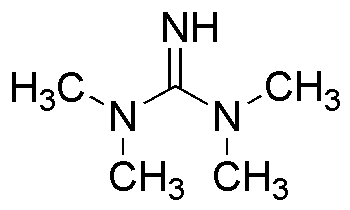1,1,3,3-Tetramethylguanidine is widely utilized in research focused on
- Organic Synthesis: This compound serves as a strong base in various organic reactions, facilitating the synthesis of complex molecules in pharmaceuticals and agrochemicals.
- Catalysis: It acts as an effective catalyst in reactions such as the synthesis of amines, enhancing reaction rates and yields compared to traditional catalysts.
- Polymer Chemistry: Used in the production of polymers, it helps in the development of high-performance materials with improved thermal and mechanical properties.
- Analytical Chemistry: This chemical is employed in analytical methods to improve the sensitivity and selectivity of detection techniques, aiding in the analysis of various substances.
- Biochemistry: It plays a role in biochemical research, particularly in studying enzyme mechanisms and interactions, providing insights into biological processes.
Informations générales
Propriétés
Sécurité et réglementation
Applications
1,1,3,3-Tetramethylguanidine is widely utilized in research focused on
- Organic Synthesis: This compound serves as a strong base in various organic reactions, facilitating the synthesis of complex molecules in pharmaceuticals and agrochemicals.
- Catalysis: It acts as an effective catalyst in reactions such as the synthesis of amines, enhancing reaction rates and yields compared to traditional catalysts.
- Polymer Chemistry: Used in the production of polymers, it helps in the development of high-performance materials with improved thermal and mechanical properties.
- Analytical Chemistry: This chemical is employed in analytical methods to improve the sensitivity and selectivity of detection techniques, aiding in the analysis of various substances.
- Biochemistry: It plays a role in biochemical research, particularly in studying enzyme mechanisms and interactions, providing insights into biological processes.
Documents
Fiches de données de sécurité (FDS)
La FDS fournit des informations de sécurité complètes sur la manipulation, le stockage et l’élimination du produit.
Spécifications du produit (PS)
Le PS fournit une description complète des propriétés du produit, notamment sa composition chimique, son état physique, sa pureté et les exigences de stockage. Il détaille également les plages de qualité acceptables et les applications prévues du produit.
Certificats d'analyse (COA)
Recherchez des certificats d'analyse (COA) en saisissant le numéro de lot du produit. Les numéros de lot et de lot se trouvent sur l'étiquette d'un produit, après les mots « Lot » ou « Lot de fabrication ».
Numéro de catalogue
Numéro de lot/série
Certificats d'origine (COO)
Ce certificat d'exploitation confirme le pays dans lequel le produit a été fabriqué, et détaille également les matériaux et composants utilisés et s'il est issu de sources naturelles, synthétiques ou autres sources spécifiques. Ce certificat peut être requis pour les douanes, le commerce et la conformité réglementaire.
Numéro de catalogue
Numéro de lot/série
Fiches de données de sécurité (FDS)
La FDS fournit des informations de sécurité complètes sur la manipulation, le stockage et l’élimination du produit.
DownloadSpécifications du produit (PS)
Le PS fournit une description complète des propriétés du produit, notamment sa composition chimique, son état physique, sa pureté et les exigences de stockage. Il détaille également les plages de qualité acceptables et les applications prévues du produit.
DownloadCertificats d'analyse (COA)
Recherchez des certificats d'analyse (COA) en saisissant le numéro de lot du produit. Les numéros de lot et de lot se trouvent sur l'étiquette d'un produit, après les mots « Lot » ou « Lot de fabrication ».
Numéro de catalogue
Numéro de lot/série
Certificats d'origine (COO)
Ce certificat d'exploitation confirme le pays dans lequel le produit a été fabriqué, et détaille également les matériaux et composants utilisés et s'il est issu de sources naturelles, synthétiques ou autres sources spécifiques. Ce certificat peut être requis pour les douanes, le commerce et la conformité réglementaire.


